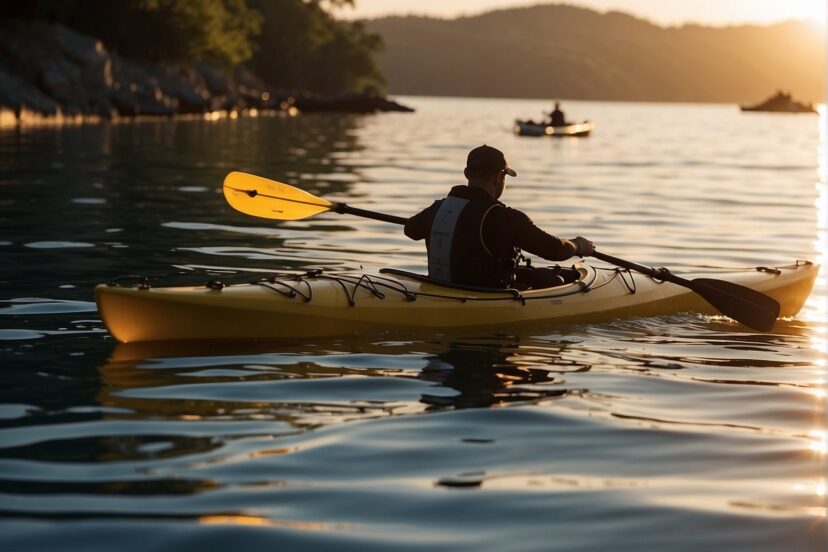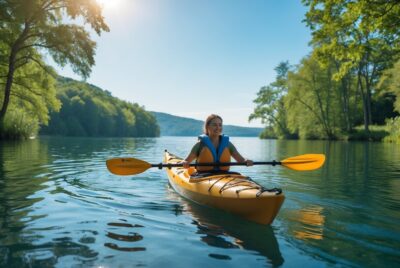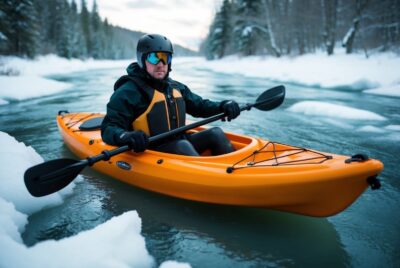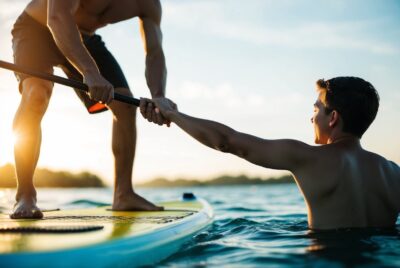Sea Kayaking Essentials: Gear and Techniques
*We may earn a commission for purchases made using our links. Please see our disclosure to learn more.
Sea Kayaking Essentials: Gear and Techniques
Sea kayaking offers a unique way to explore open water, be it along coastlines, across bays, or on the open ocean. As a seasoned kayaker, I’ve learned that sea kayaks are distinct from their recreational and whitewater counterparts due to their design. Typically, sea kayaks have a narrower and longer hull, which provides enhanced speed and stability in various ocean conditions. Their construction allows kayakers to travel longer distances and handle the challenging environment that comes with wind, waves, and currents.

Equipped with a covered deck and the ability to add a spray skirt, a sea kayak effectively keeps out water, making it a seaworthy vessel. From my experience, the right gear is critical for a safe and enjoyable sea kayaking adventure. This includes personal floatation devices, paddles designed for long-distance efficiency, and navigation tools for trips that take you out of sight of land. Sea kayaking is a sport that can cater to a range of abilities and interests, whether it’s a leisurely paddle along a calm coastline or a multi-day expedition with camping along the route.
Getting into sea kayaking requires an understanding of the basic techniques and essential safety knowledge. I’ve learned the importance of self-rescues, understanding tides and weather patterns, and the necessity of good physical conditioning. Each sea kayaking trip presents its own set of challenges and rewards, encouraging a deep respect for the marine environment and a commitment to honing one’s paddling skills. Whether I’m navigating through quiet coves or facing the swells of the open sea, each journey is a chance to connect with nature and explore the world from a different perspective.
Essentials of Sea Kayaking

Sea kayaking offers both adventure and tranquility, yet requires specific equipment and skills for a safe and enjoyable experience. I’ll guide you through the essential aspects, including choosing the right kayak and necessary gear, focusing on safety and performance.
Choosing the Right Kayak
When selecting a sea kayak, it’s crucial for me to consider hull design and construction material. Sea kayaks are specialized with features like hatches and bulkheads for storage and buoyancy, rudders or skegs for navigation, and a longer and narrower build for cutting through waves and increasing speed. I compare models to find one that suits my skill level and the type of sea conditions I expect to encounter.
- Touring Kayak vs Sea Kayak: A sea kayak is specifically outfitted for ocean conditions, often with a more robust build to handle waves and currents, unlike some touring kayaks which are designed for calmer waters.
- Cockpit Features: I look for a kayak with a comfortable and secure cockpit that comes with a spray skirt to keep me dry and the kayak buoyant during rougher conditions.
Necessary Kayaking Gear
With the sea kayak chosen, equipping myself with the right gear is paramount for safety and efficiency.
- Personal Flotation Device (PFD): An approved life jacket, designed for paddling, ensures I stay afloat in case of a capsize.
- Paddles: I carry a primary paddle suited to my size and a spare paddle secured with a paddle leash.
- Navigation: I always bring a compass and GPS, and often a VHF radio, to stay oriented and communicate in emergencies.
- Recovery Equipment: A bilge pump helps remove water from the cockpit, and I’m practiced in self-rescue techniques like the wet exit and Eskimo roll.
| Safety Gear | Purpose |
| PFD/life jacket | To ensure buoyancy in the water |
| Spray skirt | To keep water out of the kayak |
| Bilge pump | To evacuate water from the kayak’s hull |
| Paddle leash | To secure the paddle to the kayak |
| Spare paddle | Backup in case of loss or breakage of the primary |
| VHF radio | For emergency communication |
I prioritize this gear, alongside safety practices, to prepare for the unpredictability of the sea. Every piece of equipment and skill contributes to a safer, more enjoyable sea kayaking adventure.
Mastering Paddling Techniques

Mastering paddling techniques in sea kayaking is essential for efficient movement and effective navigation. I’ll outline how to refine strokes and handle varying water conditions.
Developing Efficient Strokes for Sea Kayaking
My paddling technique begins with a proper grip: hands slightly wider than shoulder-width apart, ensuring my knuckles align with the blade. I keep my strokes close to the kayak to maintain a straighter path, improving efficiency and speed. By engaging my torso with each stroke, rather than relying solely on my arms, I gain more power and endurance. I practice this rotation regularly to make it second nature.
- Catch Phase: I plant my paddle blade fully in the water near my toes.
- Power Phase: I rotate my torso, driving the blade back with power.
- Exit Phase: Around my hip, I release the blade from the water to avoid drag.
I focus on maintaining a consistent paddling rhythm, which helps me balance better and conserve energy. Remember, balance isn’t just about keeping the kayak steady; it’s a dynamic process of adjusting to the water’s movement.
Navigating Various Water Conditions
Encountering diverse conditions requires a solid foundation in various paddling strokes and knowing when to use them. I’ve honed my skills to execute turns efficiently by combining edging—leaning my kayak to one side, and using sweep strokes. This technique allows me to carve through the water responsively.
- Forward Sweep: For wide, sweeping turns, I reach forward and trace a wide arc with my paddle on the opposite side of the direction I wish to turn.
- Reverse Sweep: I initiate this to sharply turn the kayak by placing the paddle at the stern and slicing it forward in a wide arc.
Navigating currents and waves is about anticipating their impact and adjusting my paddling stroke accordingly. I employ a stroke modification known as “bracing” to maintain stability when faced with sudden turbulence.
- Low Brace: I keep my elbows bent and press the flat of my blade against the water’s surface to stabilize the kayak if I feel unbalanced.
- High Brace: I use this to prevent capsizing by quickly flipping my paddle blade upside down and slapping the water’s surface, engaging my core for an immediate correction.
Through persistent practice, I’ve learned to interpret and react to changing conditions, which is critical to mastering sea kayaking.
Understanding the Marine Environment

Before delving into the serene world of sea kayaking, I must recognize the impact of weather and water dynamics on the marine environment. I also understand the importance of respectfully interacting with marine life, ensuring my sea kayaking activities foster conservation and sustainability.
Weather and Water Dynamics
When I prepare for a sea kayaking trip, the first step is always to check the weather forecast. Weather conditions such as wind direction and speed can affect the state of the ocean, influencing both waves and currents. I know that ocean conditions including tides and currents are crucial for safe navigation.
- Tides: I monitor the tide tables to plan my entry and exit times to avoid getting stranded in low water or battling against a strong flood tide.
- Currents: I study local current charts, so I’m aware of any potential rip currents that could challenge my journey.
- Waves: Observing wave patterns helps me anticipate the movement of the water and maintain stability in my kayak.
Additionally, I always respect the power of the weather. Sudden changes in weather conditions can lead to choppy water, making navigation challenging. I maintain a solid awareness of my surroundings, including wind direction and wind speed, as both can quickly alter the difficulty of my paddle.
Interacting with Marine Life
During my paddling expeditions, I’m often fortunate enough to encounter a variety of marine life, from playful seals to majestic whales. When I interact with these creatures, I always keep a respectful distance to avoid disturbing their natural behavior or habitat.
Here are my key principles for interacting with marine life:
- Do not feed: I never feed wild animals, as this can alter their natural foraging habits.
- Keep my distance: I use binoculars for a closer look, maintaining enough distance to prevent stress to the animals.
- Move slowly and quietly: Sudden movements or loud noises can startle marine life, so I’m always gentle and discreet in my approach.
In essence, I consider my presence in the marine environment of oceans, bays, and even inland lakes as a guest, acting with mindfulness and responsibility. My goal is to ensure that my sea kayaking adventures are not only enjoyable but also harmonious with the ocean’s delicate ecosystems.
Planning Your Sea Kayaking Adventure

As an experienced kayaker, I understand that meticulous planning is crucial for a successful and enjoyable sea kayaking journey. This involves careful selection of destinations and thorough safety and emergency preparedness.
Selecting Destinations for Sea Kayaking
Coastlines and Beaches: Selecting the right destination is paramount. I look for coastlines with a variety of beaches offering both challenges for experts and safe areas for novices. I consider distance and type of water—often preferring open waters for a more adventurous experience.
Ocean Kayaking Specifics: Ocean kayaking is a different beast. When I plan these trips, I focus on the unique aspects of the ocean—tides, currents, and wind patterns. Preparation is key, and I make it a point to consult coastal reports and nautical charts.
Safety and Emergency Preparedness
Essential Gear: My safety gear checklist includes, but is not limited to:
- Personal flotation device (PFD)
- Whistle
- Flares
- Waterproof food containers
- Fully charged phone in a waterproof case
Planning for Risks: I always have a plan for quick return to shore, especially in the unpredictable ocean. I take the time to understand the risks associated with the specific destination.
Physical Fitness & Training: I cannot overstate the importance of fitness and proper kayaking technique. Recreational kayaking requires good physical condition, and I maintain mine through regular exercise. For novices, I recommend training with an instructor before tackling difficult coastlines.
Emergency Protocols: Should anything go awry, my preparation includes having emergency contact numbers and informing a friend of my plans. I carry enough food and water for emergencies, and I’m ready to use my safety gear if needed.
Preparing for a kayaking trip involves a balance of excitement for exploration and respect for the power of nature. My experiences have taught me that thorough planning is the best way to ensure safe and rewarding adventures on the water.
Advanced Sea Kayaking

In advanced sea kayaking, I address the challenges posed by varied and demanding conditions, and the importance of preparation and the right techniques required for expedition kayaking.
Challenging Conditions and Techniques
In rough water and strong currents, I need to utilize advanced techniques to maintain control and ensure safety. Bracing is a crucial skill to prevent capsizing in such conditions. This involves a proactive use of the paddle against the water’s surface to support the kayak when destabilized.
Tracking is another critical skill, which refers to the kayak’s ability to maintain a straight path. Kayaks with a v-shaped hull and pronounced rocker are designed to handle rough waters better, offering improved secondary stability — the kayak’s resistance to tipping over when leaned on its side.
My kayak is equipped with a rudder or skeg, which helps control the direction in strong currents or windy conditions. Crucial for long distance outings, these features aid in keeping my course without the need for constant corrective strokes, saving energy and improving efficiency.
- Stability Techniques:
- Primary Stability (Initial): Relates to how stable the kayak feels when I sit in it on flat water.
- Secondary Stability: Describes how the kayak behaves when it’s tilted on its side. Strong secondary stability is vital for rough-water performance.
- Recovery Techniques:
- I practice the re-enter technique to get back into my kayak after a capsize. This skill is imperative for safety during long expeditions.
When choosing a kayak for these conditions, my preference is a sit-inside model because it provides better protection from the elements and allows for more efficient use of bracing techniques. Sit-on-top kayaks can be used in warm conditions where capsizing presents less of a risk.
Expedition Kayaking
Expedition kayaking is about embarking on long-distance adventures, often in remote locations such as the rugged coastlines of Scotland or the icy waters of Alaska. This requires a kayak with ample storage space for gear, provisions, and emergency equipment. My kayak is designed with a tight and comfortable cockpit and high-grade materials like ash framing or aluminum reinforcements.
Physical fitness is essential, as expeditions demand endurance to paddle considerable distances, sometimes against challenging ocean conditions of varying tides.
- Tide Considerations:
- Low Tide: Can reveal obstacles and requires careful navigation.
- High Tide: Offers clearer passage but stronger currents.
- Required Gear:
- Navigation Supplies: Maps, compass, GPS for tracking progress.
- Safety Equipment: Flares, radio, first aid kit.
For those transitioning from recreational or beginner level kayaking to more rigorous sea voyages, it entails a serious upgrade in fitness, gear, and technical prowess. Adventure kayaking is not only about skill; it’s a commitment to discipline and understanding the power of the ocean.
The information I’ve described ensures a well-rounded understanding of advanced sea kayaking, preparing me for the demanding conditions and lengthy adventures that await in this thrilling branch of the sport.
Frequently Asked Questions
In this section, I’ll address some of the most common inquiries regarding sea kayaking, covering from essential gear to the nuances of kayaking tours and assessing route difficulties.
1. What essential gear is needed for sea kayaking?
To ensure a safe and enjoyable sea kayaking experience, you’ll need a kayak designed for open water, a paddle, personal flotation device (PFD), spray skirt, bilge pump, and appropriate clothing for the conditions. Sealed storage compartments for gear are highly recommended.
2. What are the safety precautions for kayaking in the ocean?
When kayaking in the ocean, always wear a PFD, check the weather forecast, understand tidal currents, and have navigational aids. It’s crucial to inform someone about your trip plan and time of expected return, and to kayak with a partner whenever possible.
3. How does a beginner get started with sea kayaking?
Beginners should start by taking lessons from certified instructors to learn proper paddling techniques, safety, and rescue skills. Practicing in calm, sheltered waters before moving to open ocean will build confidence and competence.
4. What are the differences between sea kayaks and other types of kayaks?
Sea kayaks are generally longer and narrower than recreational kayaks, with a defined keel and rudder or skeg for better tracking in open water. They also have watertight hatches and bulkheads for flotation and storage.
5. How does one assess the difficulty level of a sea kayaking route?
The difficulty level of a sea kayaking route is determined by factors such as distance, wind, currents, tides, and the presence of hazards like shipping traffic or rocky shores. Research the area, consult experts, and ensure it matches your skill level.




